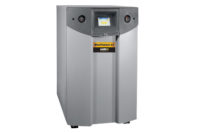During the colder months, reliability and efficiency are crucial when consumers are deciding how to heat their spaces. In many homes and businesses, consumers are opting for heating upgrades in the form of condensing boilers — a highly efficient alternative to traditional boilers that work by converting water vapor into heat.
To stay up to date with customer demand and industry trends, continued education for HVAC contractors and technicians is needed to better understand the benefits that come along with this lighter, cheaper, and more efficient alternative.
Here’s what you need to know to get started.
Condensing Boilers at a Glance
Condensing boilers operate by taking water vapor condensation to generate warmer temperatures by heating water with recycled waste gas that would otherwise escape into the atmosphere. By doing this, they are able to deliver 95% energy efficiency, which is 12% higher than noncondensing boilers that average 83% efficiency. Condensing boilers also use 13% less fuel than their counterparts.
To take an additional step, combi-condensing boilers serve a dual purpose, providing both heat and hot water. Since homes and businesses alike can trace most of their energy usage back to these two things, adopting this type of boiler marks a significant stride toward improving sustainability and energy efficiency.
Energy Savings Outlook
Highly efficient condensing boilers will save customers money on their gas bills in the long term. Consumers are also eligible for energy rebates and tax credits that, depending on the model, can provide savings of up to $2,400, alongside Energy Star’s 30% project cost tax credit for certified gas boilers with an Annual Fuel Utilization Efficiency (AFUE) of ≥ 95% on certain oil boilers.
Ultimately, the unparalleled efficiency partnered with low operating costs comes together to create a heating model that can reasonably fit into customers’ spaces and budgets.
Increased Functionality
Condensing boilers save space and time on installation, as installing a condensing boiler is a pretty seamless process for a few reasons. They are significantly lighter and are vented with PVC pipes instead of pricey metal venting, which makes it a more affordable option.
Furthermore, condensing boilers have a slew of placement options — including floor-mounted or ceiling-mounted options — and are much easier to maneuver and install. On average, condensing wall boilers are 60% smaller than conventional boilers. To compare further — a singular combi boiler weighs 79 pounds, whereas the average cast-iron boiler weighs more than 700 pounds.
Additionally, condensing boilers are equipped with modulating inverters that allow customers to properly heat their space without firing at a maximum rate. Rather, the unit can modulate itself to ensure optimal comfort and function.
Market Growth Rate and Outlook
Bosch Home Comfort’s market research shows that between 2015 and 2020, on average, condensing boiler installation increased by 6.8% annually. The same research determined a growth rate of 24.3% for combi-condensing boilers. Simply put: This technology is not going anywhere.
That being said, it is crucial that HVAC technicians, contractors, and industry leaders continue to stay in the know of consumer trends surrounding what’s evolving in popularity and are able to counsel their customers. Especially when it comes to maintaining their units, which, if neglected, can certainly lead to their unit breaking down and failing to operate as advertised.
What will continue to be crucial is proper education for consumers, and technicians who are able to navigate these new waters as products rise in popularity and guide their customers toward the option most suitable for them.







